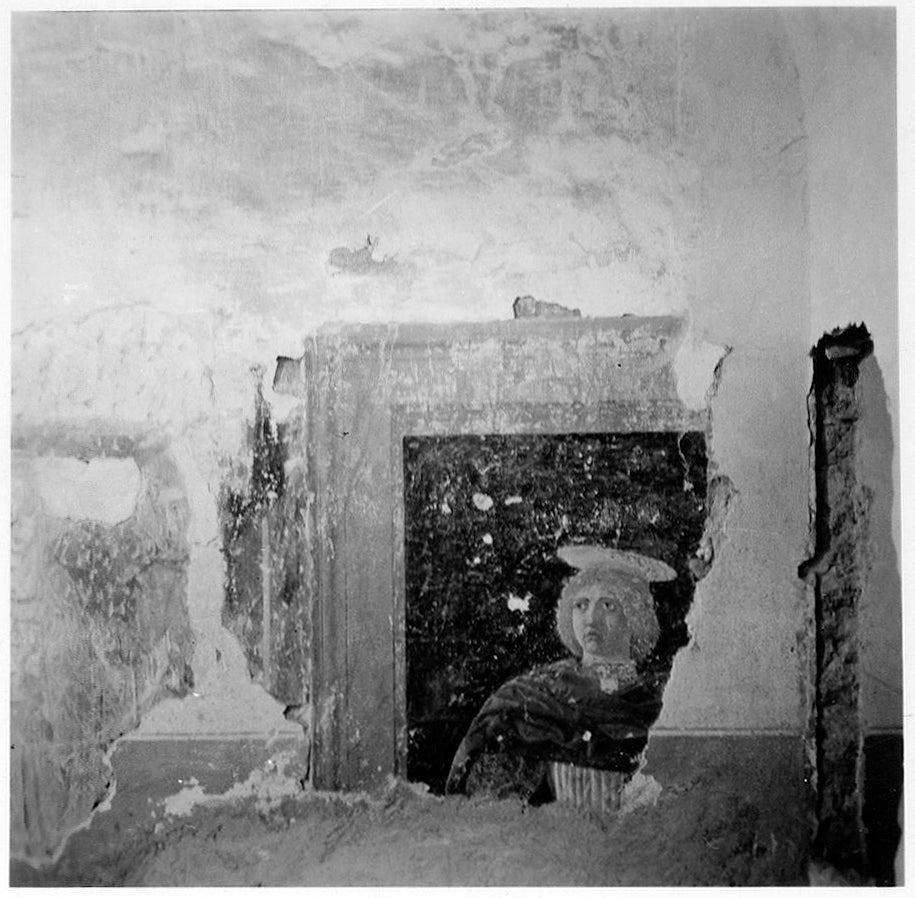June 21, 2013

In July 1956, Thomas Hoving(link is external), the former director of the Metropolitan Museum of Art, traveled to Sansepolcro, Italy, to study and photograph works by Piero della Francesca (ca. 1415–1492), including a fresco that had been discovered just nineteenth months earlier in the church of Santa Chiara(link is external) (formerly Sant’Agostino). Built about 1300, Santa Chiara had served both Augustinian and Poor Clare communities before it was deconsecrated and converted into an auditorium in the nineteenth century. The fresco fragment (illustrated above) had been concealed for centuries under layers of whitewash, and upon its discovery, plans were made to detach the painting from the wall and transfer it to the local Museo Civico(link is external). Hoving's photograph, which was donated to the Photoarchive by Nathaniel Silver, is thus a rare document of the fresco as it appeared in situ, one year before its removal to the museum. Hoving recorded the details of this “historic” photo session in his journal:
“We are up rather early this morning to pack the car and be able to have sufficient time to linger over the Resurrection frescoe [sic] and the Madonna dell Misericordia painting in the Borgo San Sepolcro as well as the newly discovered fragment of another frescoe which depicts an angel [sic] … The piece was situated in a small, filthy room in a building which is now part of a music school for young boys. It is in excellent state of preservation, this adolescent, pouting angel, and one can crawl up on a table placed in front of it and look at the painting with an eyeglass if necessary. Since the light was too low for a hand-held picture we were stumped in trying to take one of color. We would really like to have one since there has not been an adequate publication of this since its discovery in 1955. But suddenly I noticed a small window on the wall opposite to the painting which looks right on it. Here would be a steady place to put the camera for the time exposure. Now—how to get up there. There are no stairs to the balcony which approaches it—they were evidently bombed out and have never been repaired … The guide comes to the aid. We lift a very heavy railing taken from somewhere which is merely lying in the room and prop it up on the balcony like a ladder. He holds and I climb. In a few extremely dusty minutes the guerra photographia as the guide calls it is over and we have two (I hope) excellent … pictures of this masterpiece.”
 The “adolescent angel” was later identified as Julian(link is external), the legendary saint who built seven hospitals in Rome in expiation of his sins. The youthful figure, his head framed by a background of verde antico marble, originally may have been full length, and he may have held a sword in his right hand following the traditional iconography (exemplified by Domenico Ghirlandaio's depiction of the saint, illustrated). The fresco is the only surviving decoration of the lost chapel of St. John possibly commissioned by Giglio di Bartolo di Cristoforo Cresci in the early 1450s, before Piero began work on the famed polyptych(link is external) destined for the main altar of Sant’Agostino that was the focus of The Frick Collection’s exhibition Piero della Francesca in America.
The “adolescent angel” was later identified as Julian(link is external), the legendary saint who built seven hospitals in Rome in expiation of his sins. The youthful figure, his head framed by a background of verde antico marble, originally may have been full length, and he may have held a sword in his right hand following the traditional iconography (exemplified by Domenico Ghirlandaio's depiction of the saint, illustrated). The fresco is the only surviving decoration of the lost chapel of St. John possibly commissioned by Giglio di Bartolo di Cristoforo Cresci in the early 1450s, before Piero began work on the famed polyptych(link is external) destined for the main altar of Sant’Agostino that was the focus of The Frick Collection’s exhibition Piero della Francesca in America.
Piero della Francesca (ca. 1415–1492), St. Julian, ca. 1455. Fresco. Pinacoteca Comunale, Sansepolcro
Domenico Ghirlandaio (1449–1494), Detail of Madonna and Child with St. Sebastian and St. Julian, ca. 1473. Fresco. Sant'Andrea a Brozzi, San Donnino